Abstract
Face-centered cubic lattice has received extensive consideration as of late, inferable from its recognized properties and non-poisonous nature, minimal effort, plenitude, and basic creation process. The graph of a face-centered cubic cross-section contains cube points and face centres. A topological index of a molecular graph G is a numeric amount identified with G, which depicts its topological properties. In this paper, using graph theory tools, we computed the molecular descriptors (topological indices)—to be specific, Zagreb-type indices, a forgotten index, a Balaban index, the fourth version of an atom–bond connectivity index, and the fifth version of a geometric arithmetic index for face-centered cubic lattice .
Keywords:
Zagreb-type indices; forgotten index; Balaban index; atom–bond connectivity index; geometric arithmetic index; face-centered cubic lattice FCC(n) MSC:
05C12; 05C90
1. Introduction
Chemical graph theory is a branch of numerical science in which we apply apparatuses of a diagram hypothesis to demonstrate the compound marvel scientifically. This hypothesis contributes noticeably in the fields of chemical sciences. Through its assistance, some physical properties, e.g., the breaking point, can be anticipated in view of the structure of the atoms. Numerical and computational strategies are effectively used to display and foresee the structure of the issue at nuclear level []. The structures of atoms, from a numerical perspective, are graphs. Graph theory is utilized as part of relatively every field of science, and it is likewise vigorously utilized as a part of training, both for recreations and designing arrangements [,,].
Each structural formula that incorporates covalent bonded compounds or atoms is a diagram. Thus, these are called molecular graphs or basic diagrams or, perhaps more accurately, constitutional graphs. In chemistry, graph theory provides the basis for the definition, numeration, systematization of the issue closeby, it paves the way toward organizing laws or standards as per a framework or arranging terminology, and it provides the association between compounds or atoms, and PC programming. The significance of graph theory for science can be found in the presence of isomerism, which is supported by chemical graph theory [,].
As a result, it was recently noted that topological indices are utilized for bringing together QSAR models with numerous objectives, such as for DNA examination, to consider protein successions, for 2D RNA structures, to examine sedate–protein or medication–RNA quantitative structure-restricting relationships (QSBR), to encode protein surface data, and for protein association systems (PINs) [,,].
A graph is a collection of two sets, namely vertex set V and edge set E. For a graph G, the level of a vertex v is the quantity of edge episodes to v and signified by . A subatomic chart is a hydrogen-exhausted synthetic structure in which vertices signify iotas and edges indicate the bonds.
The possibility of a topological index came to light through the work of Wiener [], while he was managing the limit of paraffin. He named this rundown the Wiener index. The Wiener index is the first and most thought-out topological file, both from a theoretical point of view and applications, and described as the entire of partitions between all arrangements of vertices in G; for further information, see [].
Ghorbani and Azimi [] defined the first and second multiple Zagreb index of a graph G as:
The first Zagreb index was presented by Gutman and Trinajstic in [,]. Taken after by the first and second Zagreb indices, Furtula and Gutman [] presented the forgotten topological index as:
Gutman et al. argue that the prescient capacity, acentric factor, and entropy of the forgotten topological index are practically like those of thr first Zagreb index, and the correlation coefficients between these two are bigger than 0.95. Thus, the forgotten topological index is helpful to test the compound and pharmacological properties of medication subatomic structures. Sun et al. (2014) found some essential type of the forgotten topological index and announced that such an index can fortify the physicochemical flexibility of Zagreb indices. Recently, Gao et al. [] showed the forgotten topological index of some noteworthy medication atomic structures.
Urtula [] et al. introduced an augmented Zagreb index as:
Another topological index based on the vertex degree is the Balaban index [,]. This index for a graph G of order n, size m is defined as:
The redefined versions of the Zagreb indices were defined by Ranjini et al. [], namely, the redefined first, second, and third Zagreb index for a graph G as:
Fath-Tabar [] defined the first Zagreb polynomial and second Zagreb polynomial of a graph G as:
In 2017, Chaluvaraju et al. [] defined the first and second hyper-Zagreb polynomials of a graph G as:
The fourth version of the atom–bond connectivity index of a graph G was introduced by Ghorbhani et al. []. It was defined as:
Another molecular descriptor is the fifth version of the geometric arithmetic index of a graph G, introduced by Graovoc et al. []. It was defined as:
where and .
For more details about topological indices, see [,,,,].
2. Face-Centered Cubic Lattice
Face-centered cubic lattice comprises unit cells that are 3D squares with an atom at each edge of the solid shape and a particle in the focal point of each face of the 3D shape, see Figure 1. In our diagrams, vertices (focuses) speak to the atoms; the terms 3D square vertices (block focuses) and confront focuses (or face centre points) will be utilized, individually. An unordered pair of nodes (atoms) that specify a line joining these two nodes (atoms) is said to form an edge. In fact, the structure has the biggest pressing thickness in 3D space: This is a standout amongst the highest productive models to cover similar size circles in a volume [,], as can be found in Figure 1. Along these lines, this structure is otherwise called a cubic nearest pressed precious stone structure. Metals with an structure include copper, aluminum, nickel silver, and gold. In this paper, we utilized graphs that speak to lines of unit cells of the cross section (i.e., the measurement of our space is unit cells), see Figure 2.

Figure 1.
(a) Unit cell of ; (b) Face-centered cubic lattice .

Figure 2.
Face-centered cubic lattice .
Methodology of Face-Centered Cubic Lattice Formulas
The molecular graph of face-centered cubic lattice adds up to vertices, among which the quantity of vertices of degree 4 is , the quantity of vertices of degree 6 is 8, and the quantity of vertices of degree 9 is . Likewise, then, adding up the number of edges again gives us . To find the abstracted indices, we partition the edges of The first edge segment contains 24 edges , where and . The second edge segment contains edges , where and . The third edge segment contains 8 edges , where and . The fourth edge segment contains 8 edges , where and . The fifth edge segment contains edges , where . Table 1 shows the edge partition of with .

Table 1.
Degree-based partition of edges of face-centered cubic lattice .
3. Main Results
In the next theorems, we computed the topological indices—to be specific, the Zagreb-type indices, the forgotten index, Balaban index, augmented Zagreb index, the fourth version of atom–bond connectivity index, and the fifth version of the geometric arithmetic index for face-centered cubic lattice . Moreover, to compute our results, we used the method of combinatorial computing, analytical techniques, the vertex partition method, edge partition method, graph theoretical tools, the degree counting method, and the sum of degrees of neighbours method. Moreover, we used MATLAB for mathematical calculations and verifications. We also used the maple to plot these mathematical results.
Theorem 1.
Consider face-centered cubic lattice , then its multiple Zagreb indices are:
Proof.
Theorem 2.
Consider face-centered cubic lattice , then its forgotten topological index is equal to:
Proof.
Theorem 3.
Consider face-centered cubic lattice , then its augmented Zagreb index is:
Proof.
Let G be a the graph of face-centered cubic lattice . Now, using Table 1 and Equation (4), can be calculated as:
□
Theorem 4.
Consider face-centered cubic lattice , then its Balaban index index is:
Proof.
Theorem 5.
Consider the graph of face-centered cubic lattice , then its redefined Zegreb indices are:
Proof.
Theorem 6.
Consider face-centered cubic lattice , then its first and second Zagreb polynomials are equal to:
Proof.
Theorem 7.
Consider face-centered cubic lattice , then its first and second hyper-Zagreb polynomials are equal to:
Proof.
Table 2 shows the partition of the edges of the graph face-centered cubic lattice depending on the sum of degrees of the neighboring vertices of the end vertices of each edge. The next theorem shows the exact value of the fourth version of atom–bond connectivity index of .

Table 2.
Degree-based partition of edges of , for .
Theorem 8.
Consider the graph , then the fourth version of index for is:
Proof.
Theorem 9.
Consider the graph , then the fifth version of geometric arithmetic index of is:
4. Comparisons and Discussion
In this section, we computed all the indices for different values of n for face-centered cubic lattice . In addition, we constructed Table 3 and Table 4 for small values of n for these topological indices to the structure of face-centered cubic lattice . Now, from Table 3 and Table 4, we can easily see that all indices are in increasing order as the value of n are increases.

Table 3.
Comparison of all indices for face-centered cubic lattice .

Table 4.
Comparison of all indices for face-centered cubic lattice .
The graphical representation of the and indices is depicted in Figure 3, that of the forgotten topological index in Figure 4, that of the augmented Zagreb index in Figure 5, that of the Balaban index in Figure 6, that of the first, second, and third Zagreb indices in Figure 7, that of Zagreb polynomials and in Figure 8, that of hyper-Zagreb polynomials in Figure 9, and that of the index and index in Figure 10.
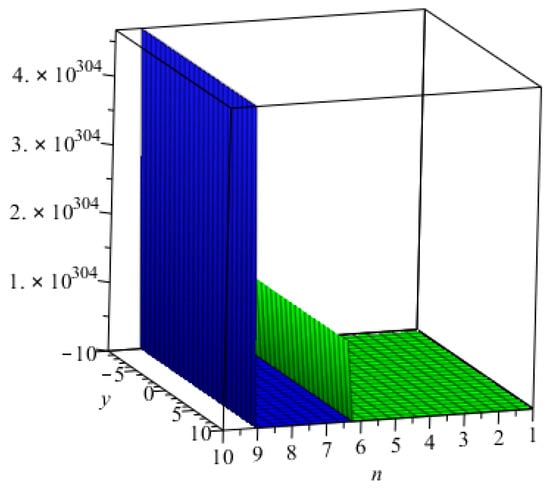
Figure 3.
The graphical representation of the and indices.
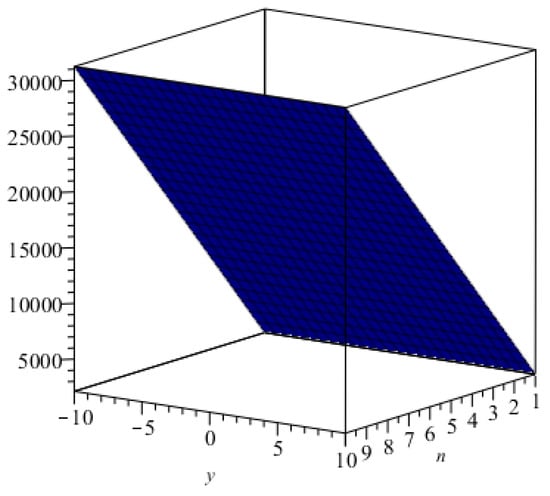
Figure 4.
The graphical representation of the forgotten topological index.
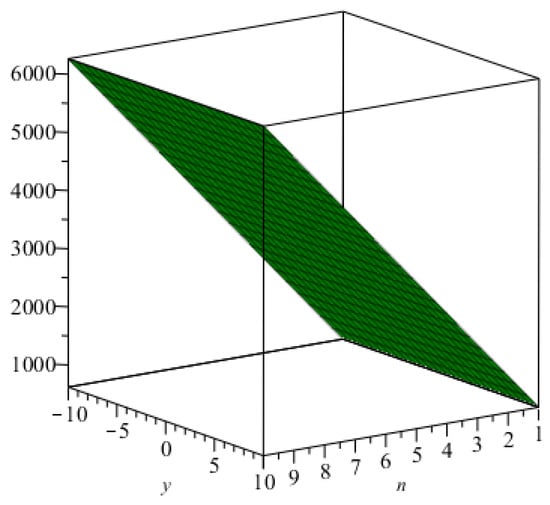
Figure 5.
The graphical representation of the augmented Zagreb index.
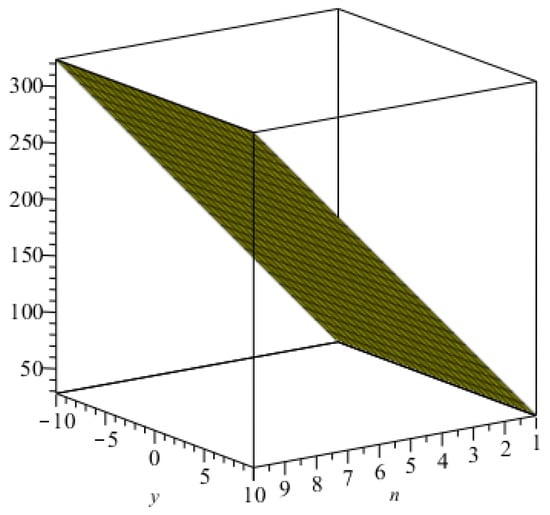
Figure 6.
The graphical representation of Balaban index.
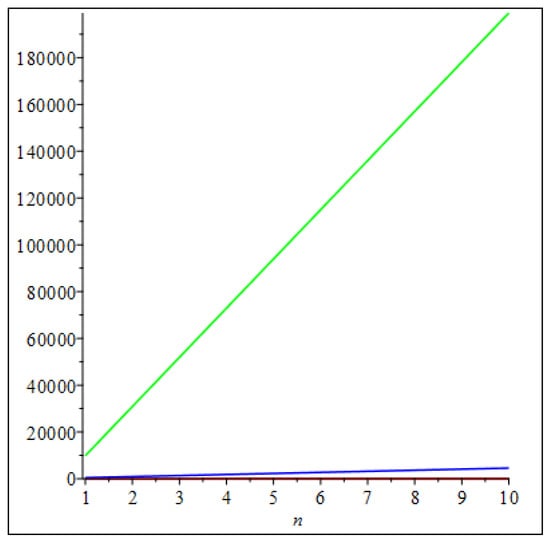
Figure 7.
The graphical representation of the first, second, and third Zagreb indices of . The red, blue, and green colors represent , , and , respectively.

Figure 8.
The graphical representation of and polynomials of face-centered cubic lattice . The colors blue and green represent and , respectively.
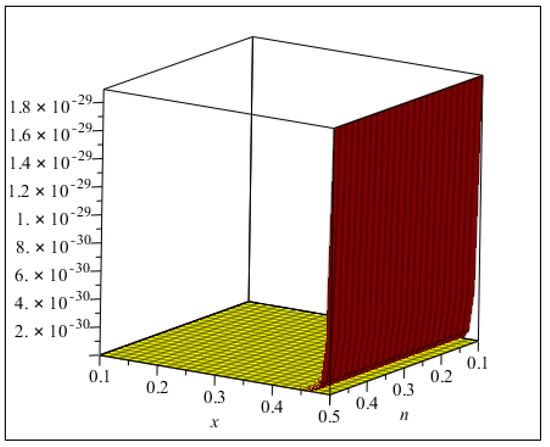
Figure 9.
The graphical representation of the first and second hyper-Zagreb polynomial in a structure of face-centered cubic lattice . The colors blue and green represent and , respectively.
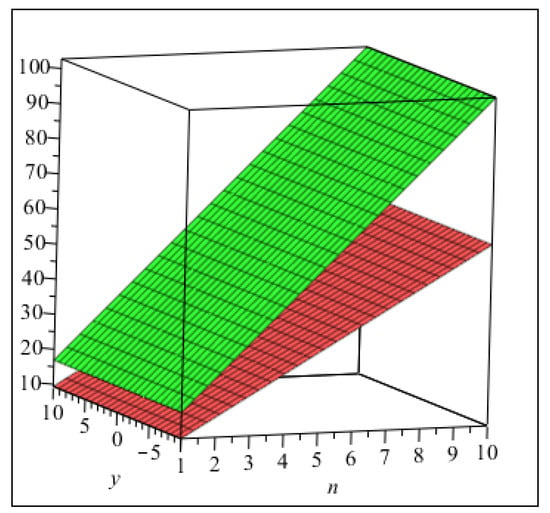
Figure 10.
The graphical representation of index and index of face-centered cubic lattice . The colors brown and green represent and , respectively.
5. Conclusions
In this paper, we studied a reputable lattice, namely face-centered cubic lattice , and we determined the topological indices, namely the Zagreb-type indices, the forgotten index, Balaban index, the fourth version of , and the fifth version of the geometric arithmetic index for face-centered cubic lattice .
Since the first and second multiple Zagreb indices, redefined Zagreb indices were found to occur for computation of the total -electron energy of the molecules; in the case of face-centered cubic lattice , their values provide total -electron energy in increasing order for higher values of n. Moreover, the forgotten topological index, Balaban index, and augmented Zagreb index announced that the physicochemical flexibility of face-centered cubic lattice is fruitful for chemical reactions. Further, the fourth atom–bond connectivity and the fifth version of the geometric arithmetic index index provide a very good correlation for computing the strain energy of molecules; one can easily see that the strain energy of face-centered cubic lattice is higher as the values of n increases. Additionally, these result are helpful from a chemical point of view as well as in pharmaceutical science. However, computing the distance-based and counting-related topological indices for these symmetrical chemical structures still remains open for investigation and a challenge for researchers.
Author Contributions
H.Y. contributed in conceptualization, designing the experiments, funding, supervision, and analyzing the data. M.K.S. and S.S.K. contributed in methodology, software, validation, and formal analyzing. M.A.R. and S.A. contributed in performing the experiments, resources, some computations, and writing the initial draft of the paper. M.K.S. and S.A. investigated and wrote the final draft. All authors read and approved the final version of the paper.
Funding
This work was supported by the Soft Scientific Research of Sichuan Province under grant 2018ZR0265, Sichuan Military and Civilian Integration Strategy Research Center under grant JMRH-1818, and Sichuan Provincial Department of Education (Key Project) under grant 18ZA0118.
Acknowledgments
The authors are grateful to the anonymous referees for their valuable comments and suggestions that improved this paper.
Conflicts of Interest
The authors declare no conflict of interest.
References
- Catlow, C.R.A. Modelling and predicting crystal structures. Interdiscip. Sci. Rev. 2015, 40, 294–307. [Google Scholar] [CrossRef]
- Bača, M.; Horváthová, J.; Mokrišová, M.; Suhányiová, A. On topological indices of fullerenes. Appl. Math. Comput. 2015, 251, 154–161. [Google Scholar] [CrossRef]
- Bača, M.; Horváthová, J.; Mokrišová, M.; Semanicová-Fenovcíková, A.; Suhányiová, A. On topological indices of carbon nanotube network. Can. J. Chem. 2015, 93, 1–4. [Google Scholar] [CrossRef]
- Gao, W.; Siddiqui, M.K. Molecular Descriptors of Nanotube, Oxide, Silicate, and Triangulene Networks. J. Chem. 2017, 2017, 6540754. [Google Scholar] [CrossRef]
- Imran, M.; Siddiqui, M.K.; Naeem, M.; Iqbal, M.A. On Topological Properties of Symmetric Chemical Structures. Symmetry 2018, 10, 173. [Google Scholar] [CrossRef]
- Imran, M.; Ali, M.A.; Ahmad, S.; Siddiqui, M.K.; Baig, A.Q. Topological Characterization of the Symmetrical Structure of Bismuth Tri-Iodide. Symmetry 2018, 10, 201. [Google Scholar] [CrossRef]
- Gao, W.; Siddiqui, M.K.; Naeem, M.; Rehman, N.A. Topological Characterization of Carbon Graphite and Crystal Cubic Carbon Structures. Molecules 2017, 22, 1496. [Google Scholar] [CrossRef]
- Gharibi, W.; Ahmad, A.; Siddiqui, M.K. On Zagreb Indices, Zagreb Polynomials of Nanocone and Nanotubes. J. Comput. Theor. Nanosci. 2016, 13, 5086–5092. [Google Scholar] [CrossRef]
- Idrees, N.; Naeem, M.N.; Hussain, F.; Sadiq, A.; Siddiqui, M.K. Molecular descriptors of benzenoid system. Quimica Nova 2017, 40, 143–145. [Google Scholar] [CrossRef]
- Wiener, H. Structural determination of paraffin boiling points. J. Am. Chem. Soc. 1947, 69, 17–20. [Google Scholar] [CrossRef]
- Dobrynin, A.A.; Entringer, R.; Gutman, I. Wiener index of trees: Theory and applications. Acta Appl. Math. 2001, 66, 211–249. [Google Scholar] [CrossRef]
- Ghorbani, M.; Azimi, N. Note on multiple zagreb indices. Iran. J. Math. Chem. 2012, 3, 137–143. [Google Scholar]
- Gutman, I.; Das, C.N. The first Zagreb index 30 years after. MATCH Commun. Math. Comput. Chem. 2004, 50, 83–92. [Google Scholar]
- Gutman, I.; Trinajst, N. Graph theory and molecular orbitals, Total π-electron energy of alternant hydrocarbons. Chem. Phys. Lett. 1972, 17, 535–538. [Google Scholar] [CrossRef]
- Furtula, B.; Gutman, I. A forgotten topological index. J. Math. Chem. 2015, 53, 1184–1190. [Google Scholar] [CrossRef]
- Gao, W.; Siddiqui, M.K.; Imran, M.; Jamil, M.K.; Farahani, M.R. Forgotten Topological Index of Chemical Structure in Drugs. Saudi Pharm. J. 2016, 24, 258–267. [Google Scholar] [CrossRef]
- Furtula, B.; Graovac, A.; Vukicevic, D. Augmented zagreb index. J. Math. Chem. 2010, 48, 370–380. [Google Scholar] [CrossRef]
- Balaban, A.T. Highly discriminating distance-based topological index. Chem. Phys. Lett. 1982, 89, 399–404. [Google Scholar] [CrossRef]
- Balaban, A.T.; Quintas, L.V. The smallest graphs, trees, and 4-trees with degenerate topological index. J. Math. Chem. 1983, 14, 213–233. [Google Scholar]
- Ranjini, P.S.; Lokesha, V.; Usha, A. Relation between phenylene and hexagonal squeez using harmonic index. Int. J. Graph. Theory 2013, 1, 116–121. [Google Scholar]
- Fath-Tabar, G.H. Zagreb Polynomial and Pi Indices of some Nano Structures. Dig. J. Nanomater. Biostruct. 2009, 4, 189–191. [Google Scholar]
- Chaluvaraju, B.; Boregowda, H.S.; Diwakar, S.A. Hyper-Zagreb indices and their polynomials of some special kinds of windmill graphs. Int. J. Adv. Math. 2017, 4, 21–32. [Google Scholar]
- Ghorbani, A.; Hosseinzadeh, M.A. Computing ABC4 index of nanostar dendrimers. Optoelectron. Adv. Mater. Rapid Commun. 2010, 4, 1419–1422. [Google Scholar]
- Graovac, A.; Ghorbani, M.; Hosseinzadeh, M.A. Computing fifth geometric–arithmetic index for nanostar dendrimers. J. Math. Nanosci. 2011, 1, 33–42. [Google Scholar]
- Siddiqui, M.K.; Imran, M.; Ahmad, A. On zagreb indices, zagreb polynomials of some nanostar dendrimers. Appl. Math. Comput. 2016, 280, 132–139. [Google Scholar] [CrossRef]
- Siddiqui, M.K.; Gharibi, W. On Zagreb Indices, Zagreb Polynomials of Mesh Derived Networks. J. Comput. Theor. Nanosci. 2016, 13, 8683–8688. [Google Scholar] [CrossRef]
- Siddiqui, M.K.; Naeem, M.; Rahman, N.A.; Imran, M. Computing topological indices of certain networks. J. Optoelectron. Adv. Mater. 2016, 18, 884–892. [Google Scholar]
- Kang, S.M.; Siddiqui, M.K.; Rehman, N.A.; Naeem, M.; Muhammad, M.H. Topological properties of 2-dimensional silicon-carbons. IEEE Access 2018, 6, 59362–59373. [Google Scholar] [CrossRef]
- Gao, W.; Siddiqui, M.K.; Naeem, M.; Imran, M. Computing multiple ABC index and multiple GA index of some grid graphs. Open Phys. 2018, 16, 588–598. [Google Scholar] [CrossRef]
- Conway, J.H.; Sloane, N.J.A. Sphere Packings, Lattices, and Groups, 2nd ed.; Springer: New York, NY, USA, 1993. [Google Scholar]
- Mujahed, H.; Nagy, B. Exact Formula for Computing the Hyper-Wiener Index on Rows of Unit Cells of the Face-Centred Cubic Lattice. An. Univ. Ovidius Constanta 2018, 26, 169–187. [Google Scholar] [CrossRef]
© 2019 by the authors. Licensee MDPI, Basel, Switzerland. This article is an open access article distributed under the terms and conditions of the Creative Commons Attribution (CC BY) license (http://creativecommons.org/licenses/by/4.0/).